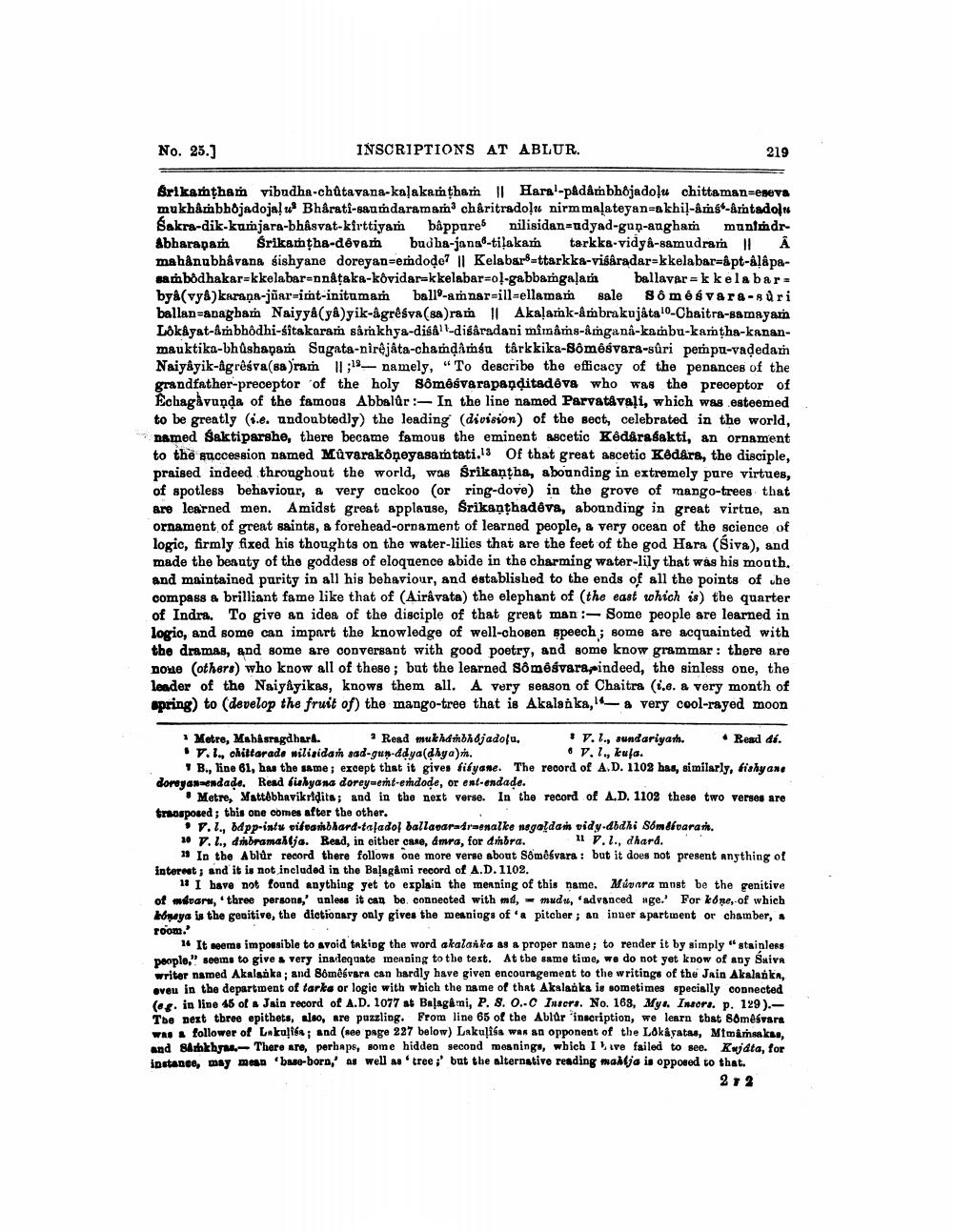________________
No. 23.)
INSCRIPTIONS AT ABLUR.
219
Srikanthaṁ vibudha-chûtavana-kalakartham || Haral-pådam bhojadolu chittaman=eneva mukhåmbhojadojal u Bhårati-saudaramam charitrado!r nirmmalateyan akhil-âms-årtado Sakra-dik-kumjara-bhâsvat-kirttiyan bâppareb nilisidan=udyad-gun-angham manimdrAbharaṇa Srikamtha-devam budha-jana-tilakam tarkka-vidyâ-samudram || Å mah&nabhåvana sishyane doreyan=emdode7 || Kelabarsttarkka-visâradar=kkelabar=&pt-alapasanbodhakar=kkelabar=nnataka-kövidar=kkelabar=o!-gabbamgalan ballavar = k kela bar: by&(vys) karana-jñar-imt-initumam ballo-amnar=ill-ellamam sale 8ômés vara-gůri ballan=anagham Naiyya(ya)yik-agrêsva(sa)ram 11 Akalamk-&nbrakujátało-Chaitra-lamayam Lôkåyat-ambhôdhi-sitakaram simkhya-disall-disaradani mimams-åmgang-kambu-kartha-kananmauktika-bhushanam Sagata-nirêjáta-chamdámsu tarkkika-8ômésvara-sûri pempu-vadedam Naiyáyik-agreśva (sa)ram 11;_namely, “To describe the efficacy of the penances of the grandfather-preceptor of the holy Sômêsvarapanditadáve who was the preceptor of Echagåvaņda of the famous Abbalûr :- In the line named Parvatávali, which was esteemed to be greatly i.e. undoubtedly) the leading (division of the sect, celebrated in the world, named Saktiparshe, there became famous the eminent ascetic Kédarasakti, an ornament to the succession named Mûvarakoņogasamtati.l3 Of that great ascetic Kedåra, the disciple, praised indeed throughout the world, was Srikantha, abounding in extremely pure virtues, of spotless behaviour, a very cuckoo (or ring-dove) in the grove of mango-trees that are learned men. Amidst great applause, Srikanthadêve, abounding in great virtue, an ornament of great saints, a forehead-ornament of learned people, & very ocean of the science of logic, firmly fixed his thoughts on the water-lilies that are the feet of the god Hara (Śiva), and made the beauty of the goddess of eloquence abide in the charming water-lily that was his month. and maintained purity in all his behaviour, and established to the ends of all the points of whe compass a brilliant fame like that of (Airavata) the elephant of the east which is the quarter of Indra. To give an idea of the disciple of that great man: Some people are learned in logio, and some can import the knowledge of well-chosen speech; some are acquainted with the dramas, and some are conversant with good poetry, and some know grammar: there are none others) who know all of these; but the learned Sômêsvara pindeed, the sinless one, the leader of the Naiyayikas, knows them all. A very season of Chaitra (i.e. & very month of spring) to (develop the fruit of) the mango-tree that is Akala ka, a very cool-rayed moon
Metre, Mahásragdhara.
7. 1., sundariyath. Read di. 7. I., chittarade #ilisidan sad-gun-ddya(dhya)h.
OV.., kula. * B., line 61, has the same; except that it gives fibyane. The record of A.D. 1102 has, similarly, fishy ane doreyanaendade. Read fishyana dorey=ent-endode, or ent-ondade.
• Metre, Mattebhavikridits; and in the next verse. In the record of A.D. 1102 these two verses are trosposed; this one comes after the other.
• 7.1., odpp-intu vilvanbhard-taladol ballapararenalke naga dan vidy.dodhi Sóm divaran. 20 7. l., dubramalja. Read, in either cane, dmra, for dúbra. 11 .l., dhard.
11 In the Ablur record there follows one more verse about Sômêśvara : but it does not present anything of interest, and it is not included in the Balagami record of A.D. 1102.
11 I have not found anything yet to explain the meaning of this name. Múvara must be the genitive of w ars, three persons,' unless it can be connected with md, mudu, 'advanced uge. For kone, of which koreya is the genitive, the dictionary only gives the meaniogs of a pitcher; an inuer apartment or chamber, room.
14 It seems impossible to avoid taking the word akalanka as a proper name; to render it by simply "stainless people," seems to give a very inadequate meaning to the test. At the same time, we do not yet know of any Suiva writer named Akalaaka; and Bômêśvara can hardly have given encouragement to the writings of the Jain Akala kn, oveu in the department of tarka or logic with which the name of that Akala ka is sometimes specially connected (e. in line 45 of Jain record of A.D. 1077 at Balagê mi, P. 8. O.. Insers. No. 169, Mys. Insors. p. 129).The next three epithets, also, are puzzling. From line 65 of the Ablar 'inscription, we learn that some vara W follower of Likulise; and (nee page 227 below) Lakulia was an opponent of the Lokayatas, Mimimsakse and Stakhya - There are, perhaps, some hidden second meanings, which I have failed to see. Kujdta, for instance, may mean 'base-born, as well as tree;' but the alternative reading mahlja is opposed to that.
2 1 2




